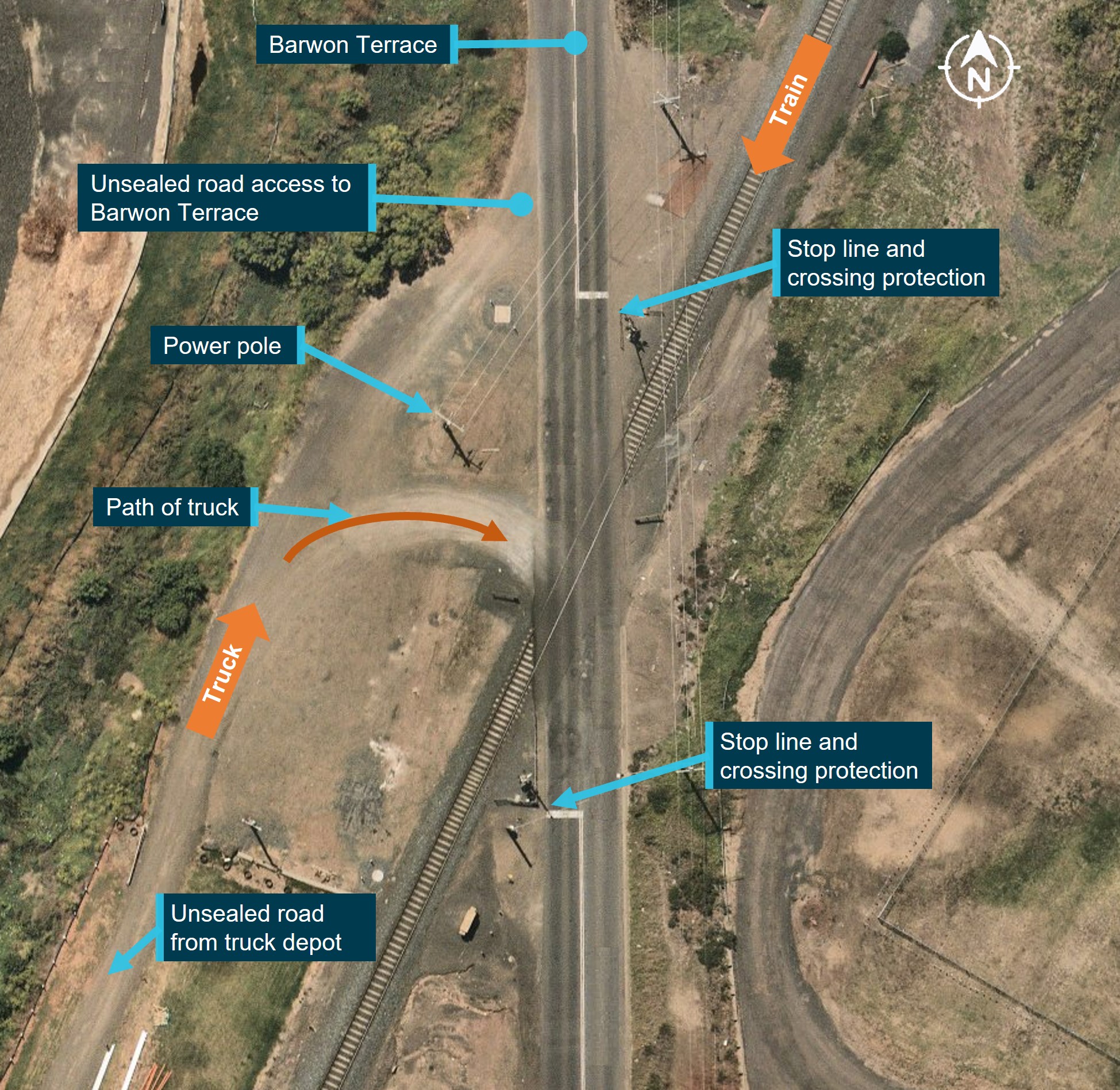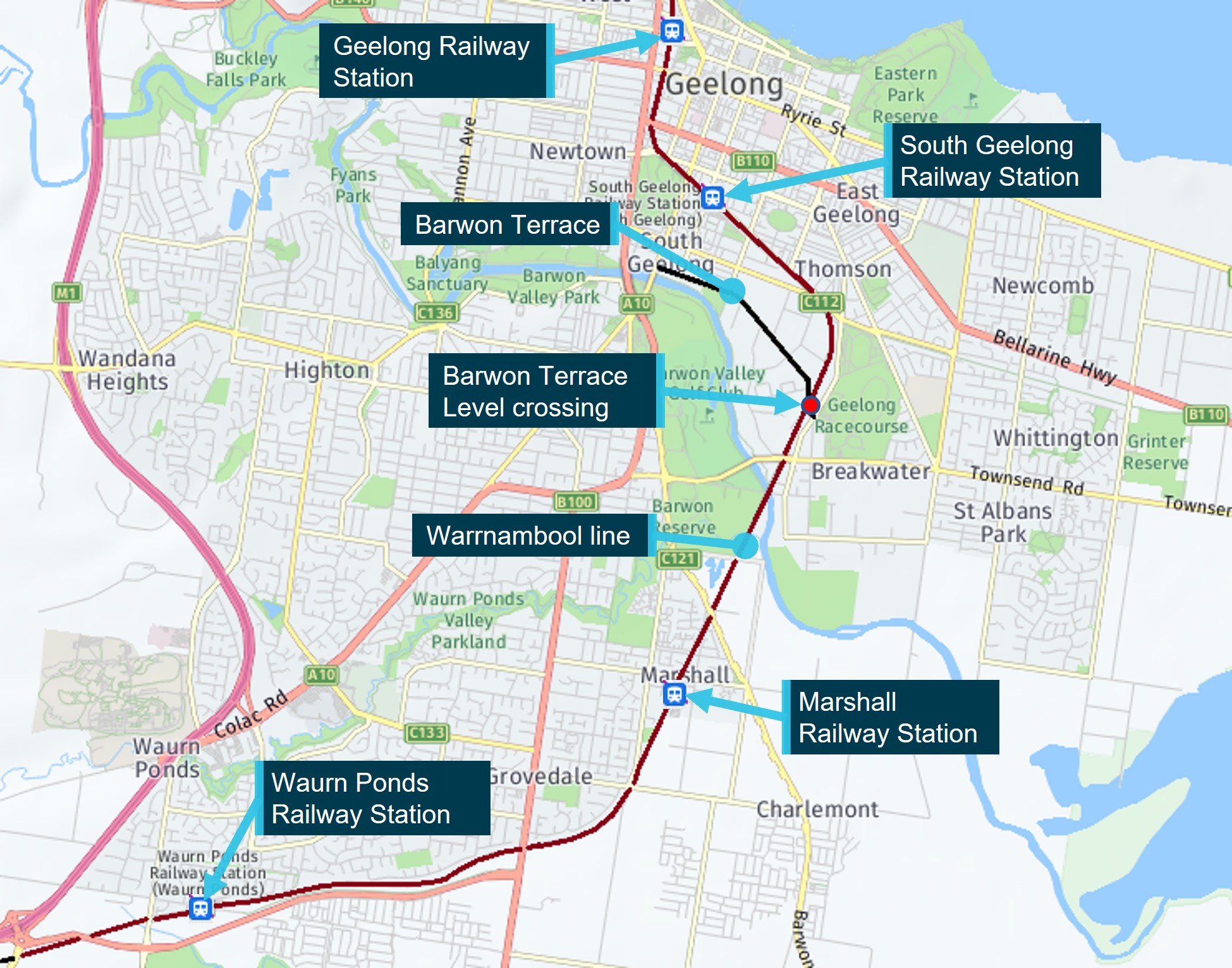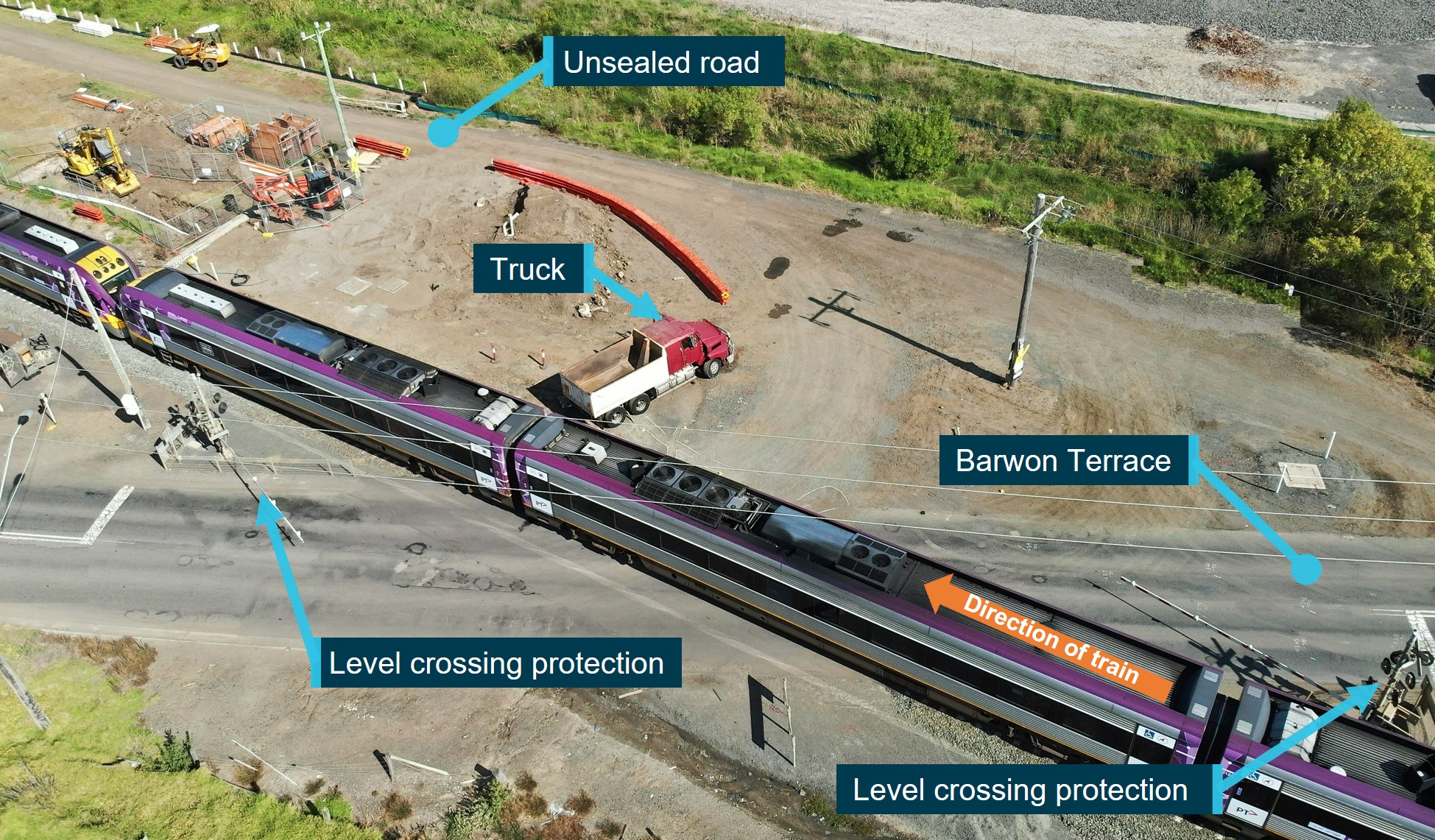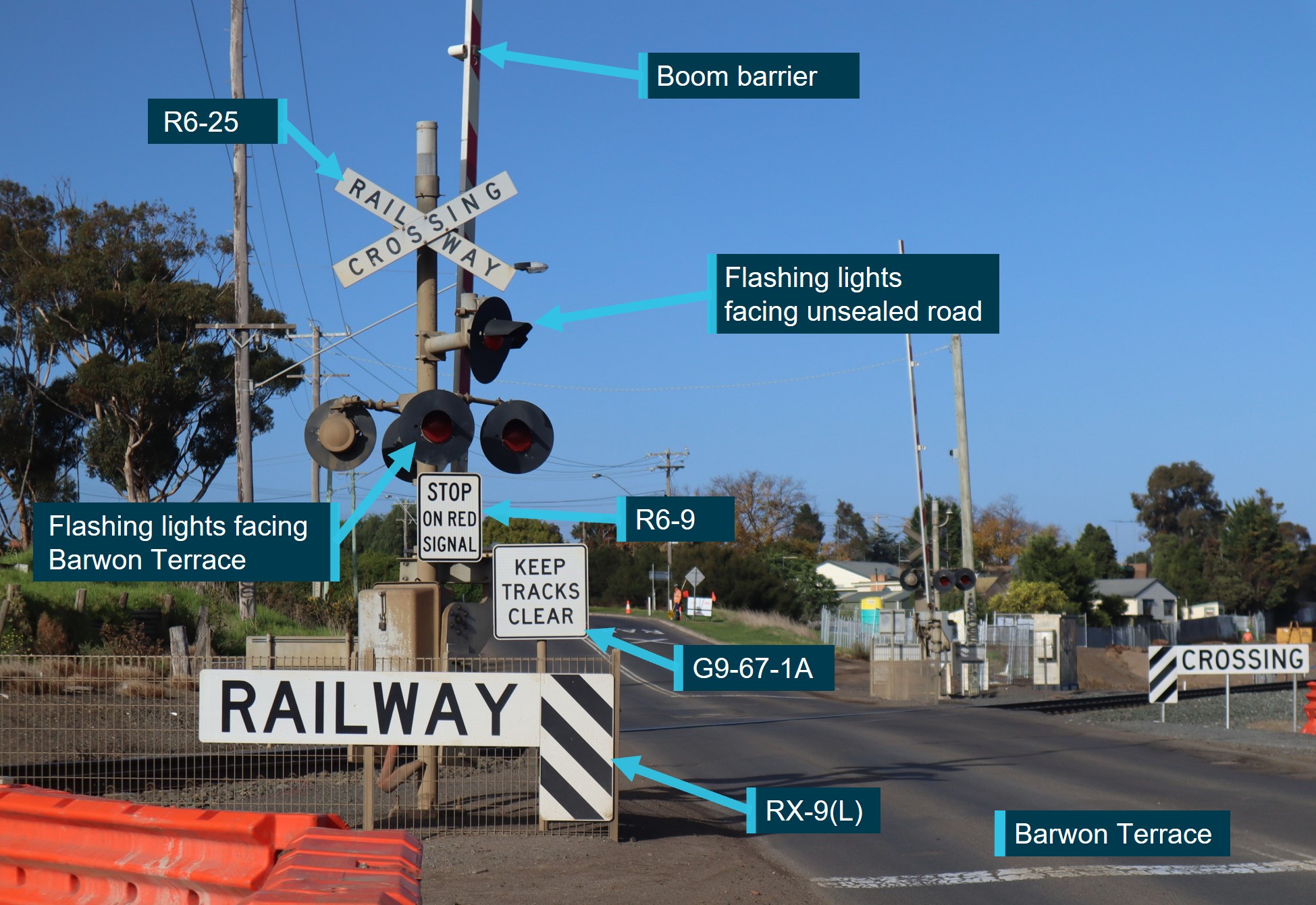Investigation summary
What happened
On 3 April 2023, at about 0636, empty V/Line passenger train 7727, running from Geelong to Waurn Ponds, Victoria was approaching Barwon Terrace level crossing in South Geelong, Victoria. At about the same time, a tip truck from a nearby heavy vehicle depot drove onto the level crossing from an unsealed side road. The side road configuration meant that vehicles could enter the level crossing between the level crossing active protection and the track.
The driver of the truck probably became aware of the approaching train and attempted to reverse their vehicle away from the track. However, the train collided with the truck before the truck was clear. The collision rotated the truck about 180° and the driver sustained fatal injuries. The train crew were uninjured.
What the ATSB found
The unsealed road access near the track had developed in recent years. CCTV footage of traffic movements in the weeks before the collision indicated that it was common practice for both light and heavy vehicles to turn right from the unsealed road onto Barwon Terrace between the level crossing protection of booms and flashing lights and the track.
Although the level crossing was inspected regularly by the rail infrastructure manager (V/Line), the inspections did not include a review of the emerging risks associated with the changing road usage and configuration at the level crossing. The safety interface agreement between rail operators and the road manager (the City of Greater Geelong) was also ineffective in triggering action by the agreement partners to monitor the road to rail interface and changing usage.
It was also found that the emerging hazard was identified by personnel from a rail infrastructure project undertaking works in the area. Although there were attempts to reduce the risk associated with the hazard by placing a sign to prohibit users from using the exit route close to the track, this proved ineffective. Signage was ignored by many users of the unsealed access road. There was a missed opportunity for identified hazards associated with the level crossing to be brought to the attention of the appropriate operational area of V/Line.
What has been done as a result
V/Line has issued a maintenance alert with actions for track inspectors to identify roads or access tracks which may be able to bypass crossing controls and raise corrective work orders and incident reports in response. In addition, V/Line advised that the Level Crossing Roadway Inspection Report form has been revised to include an assessment of hazardous access points.
The Victorian Rail Crossing Safety Steering Committee (VRCSSC) has implemented changes to the Australian Level Crossing Assessment Model (ALCAM) survey program in Victoria, that now requires contractors undertaking assessments to identify and report any road network configurations like the incident location. If reported, the rail infrastructure manager would be notified of the safety risk and further assessment and actions sought.
Safety message
Level crossing inspection regimes should include checks on any changes that may introduce new hazards and associated risks.
The occurrence
Prior to the incident
At about 0631 local time on 3 April 2023, V/Line train 7727 departed Geelong Railway Station to travel to Waurn Ponds, Victoria (Figure 1). Train 7727 was an empty, 6-car VLocity train with only the driver and conductor on board. The train was being relocated to Waurn Ponds to form the 0721 passenger service from Waurn Ponds to Melbourne. For its relocation, the train was not scheduled to stop at South Geelong or Marshall stations.
Figure 1: Train route and location of Barwon Terrace level crossing
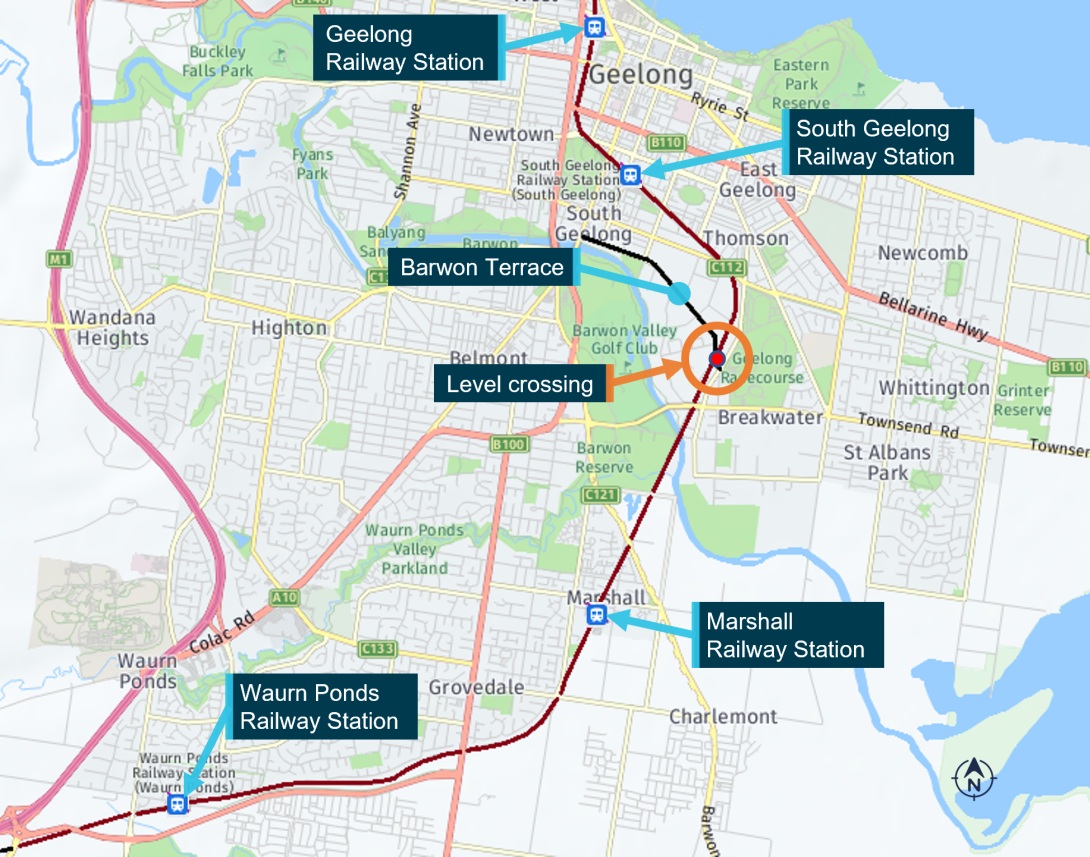
Source: Imagery © Nearmap annotated by Office of the Chief Investigator
Earlier, at about 0600, a truck driver arrived at a heavy vehicle depot adjacent to the rail corridor and began preparing a tip truck for work. The depot was located about 220 m south of the Barwon Terrace level crossing on the western side of the rail line. Access from the depot to Barwon Terrace was via an unsealed road[1] which ran parallel to the rail line and joined Barwon Terrace at the northern end of the road.
The collision
At about 0635, the truck left the depot and travelled north along the unsealed road towards Barwon Terrace. It was dawn (shortly before sunrise), overcast and dry. As the truck approached the northern end of the unsealed road, the truck turned to the right and drove slowly onto the level crossing (Figure 2). This positioned the truck between the protection equipment located on each side of the crossing. The level crossing flashing lights and bells were operating, and booms had descended. At the same time, train 7727 approached the level crossing from the north.
Figure 2: Direction of travel of train and route of truck onto the level crossing
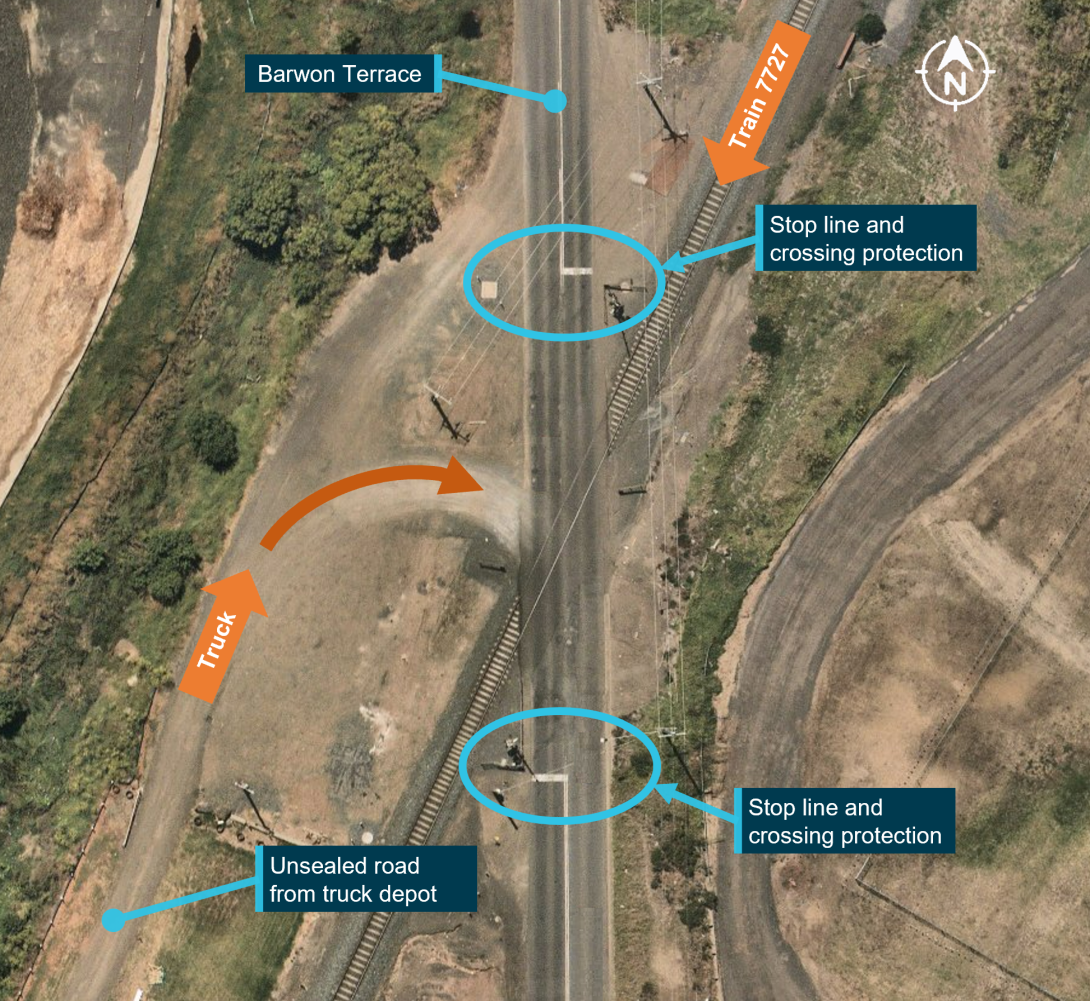
Source: Imagery © Nearmap, annotated by the Office of the Chief Investigator
Train 7727 approached the crossing with its headlights on and travelling at about 74 km/h. On observing the truck, the driver of the train commenced braking[2] and sounded the train’s horn when about 107 m from the collision point. Northbound road traffic had stopped and was queuing behind the boom barrier to the south of the crossing.
On its approach, the train was clearly visible from the level crossing from about 350 m. By either direct observation of the train or hearing the train’s horn and/or observation of the horizontal boom and queued traffic south of the crossing, the truck driver was alerted to the presence of the approaching train. The truck came to a stop. The truck then began to reverse but did not clear the track before the train collided with the left-front side of the truck. The train was travelling at about 60 km/h at the time of the collision. The impact spun the truck around in a clockwise direction and the driver was fatally injured. The train driver and the conductor were not injured.
Context
Barwon Terrace level crossing
Road – rail interface
Barwon Terrace was a sealed bi-directional dual lane motor vehicle carriageway managed by the City of Greater Geelong (COGG). At its intersection with the rail line, Barwon Terrace ran in a north / south direction. Travelling south away from Geelong, Barwon Terrace intersected the rail track at the level crossing at an angle of about 25 degrees to the road user’s left (Figure 3). The maximum speed permitted on Barwon Terrace was 60km/h.
Figure 3: Barwon Terrace interface with rail line
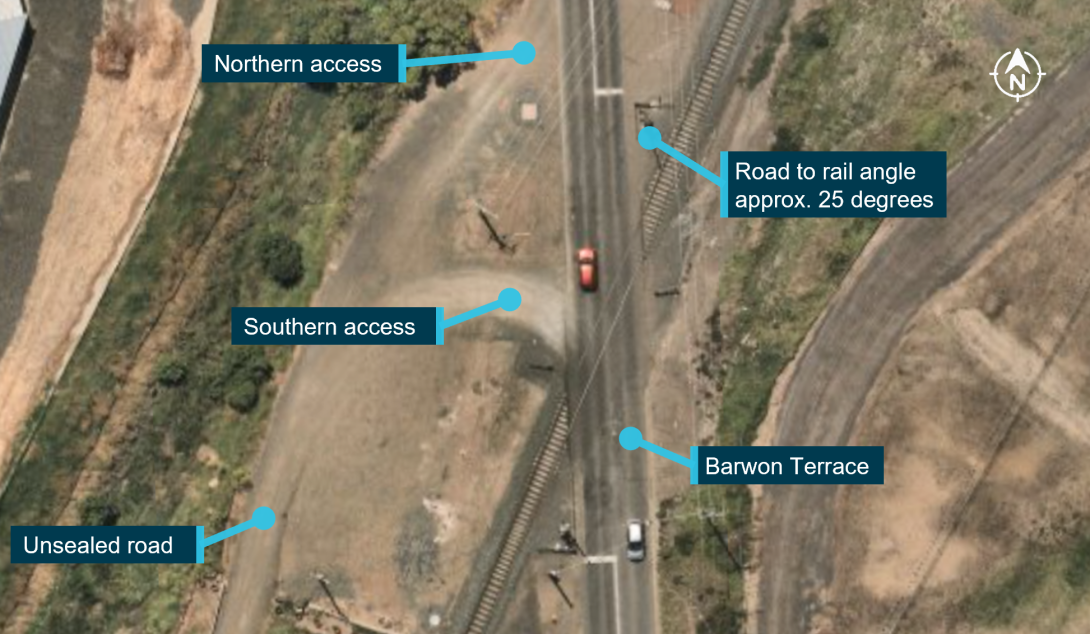
Source: Nearmap, annotated by the Office of the Chief Investigator
Barwon Terrace level crossing was an active level crossing located on rail land leased by VicTrack[3] to Head Transport for Victoria[4] and sub-leased to V/Line. V/Line maintained and managed the level crossing.[5]
The rail line, at its intersection with Barwon Terrace, was a single bi-directional broad gauge track with concrete sleepers on a level gradient and formed part of the Warrnambool rail line. The maximum permitted speed for passenger trains travelling along that section of the rail line was 115 km/h.
Level crossing protection
Australian Standard, Manual of uniform traffic control devices, Part 7: Railway crossings (AS 1742.7 – 2016), specified the signage requirements for level crossings with active controls. Protection at the crossing was typical of an active level crossing over a single rail track and consistent with the standard. The protection consisted of boom barriers, flashing lights, warning bells and warning signage on each side of the crossing.
For road traffic approaching from the north, railway crossing warning signage included an RX-5 railway crossing flashing signal assembly,[6] a Keep Tracks Clear Sign (G9-67-1A) and a Railway Crossing with marker assembly sign (RX-9) (Figure 4).[7] There was a pair of standard flashing lights for southbound Barwon Terrace traffic and an additional flashing light directed towards the exit of the unsealed road. This single flashing light was directed to the northern access of the unsealed road and could not be clearly seen from the southern exit nearer the track crossing and used by the truck.
Figure 4: Level crossing protection for southbound traffic
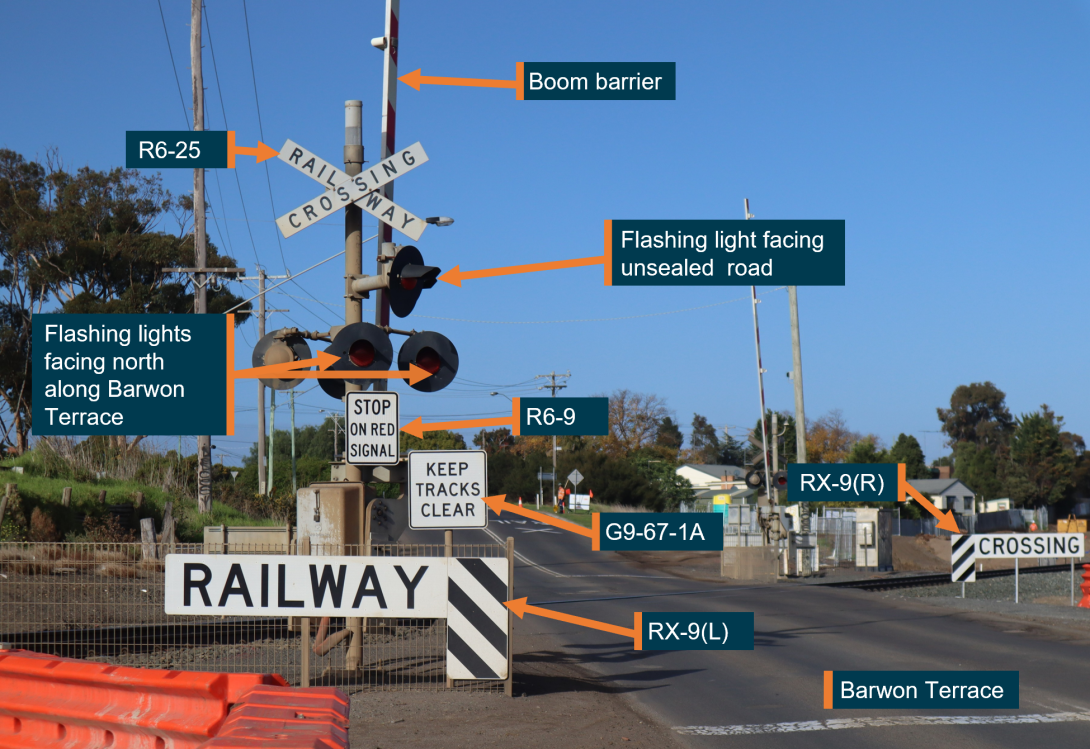
The figure shows the protection equipment at the level crossing on the western side of the crossing. Source: The Office of the Chief Investigator
Inspection and maintenance
V/Line regularly serviced the level crossing and tested the crossing operability.[8] Inspection included testing the backup battery at the crossing. The crossing was serviced about 3 weeks prior to the incident and was found to be functioning as intended.
This inspection process did not include assessing the junction between Barwon Terrace and the access onto the tracks from the unsealed road.
The protection equipment at the crossing was working at the time of the incident. This was confirmed by CCTV, download data taken from the crossing equipment following the incident and eyewitnesses accounts.
ALCAM level crossing assessment
The Australian Level Crossing Assessment Model (ALCAM)[9] was an assessment tool used to identify potential risks at level crossings, to assist in the prioritisation of crossings for upgrades and support the decision-making process when determining the most cost‑effective treatments at a level crossing. The Victorian Rail Crossing Steering Committee (VRCSSC) delivered the level crossing safety strategy in Victoria and funded ALCAM surveys. Membership of this committee included the Australian Rail Track Corporation, V/Line Corporation, Metro Trains Melbourne, VicTrack, Victoria Police and the Victorian Department of Transport and Planning.
The survey of a level crossing produced an ALCAM Risk Score expressed as the expected number of equivalent fatalities at that level crossing per year. The ALCAM Risk Score was described as allowing ‘comparison of level crossings against each other within a given jurisdiction based on the level of risk’ and informed safety improvement programs.[10]
The most recent (prior to the collision) full ALCAM survey at the Barwon Terrace level crossing was conducted in July 2017 and reviewed in 2018. The assessment and review noted that flashing lights, bells and audible warning devices and the relevant level crossing signage were deployed at the crossing. The survey drawing prepared from the survey in 2017 and associated photographs at that time indicated that the used route to and from the unsealed road was on its northern interface, and not the southern access later used nearer to the track (Figure 5).
Figure 5: Junction between the access road and Barwon Terrace in 2017
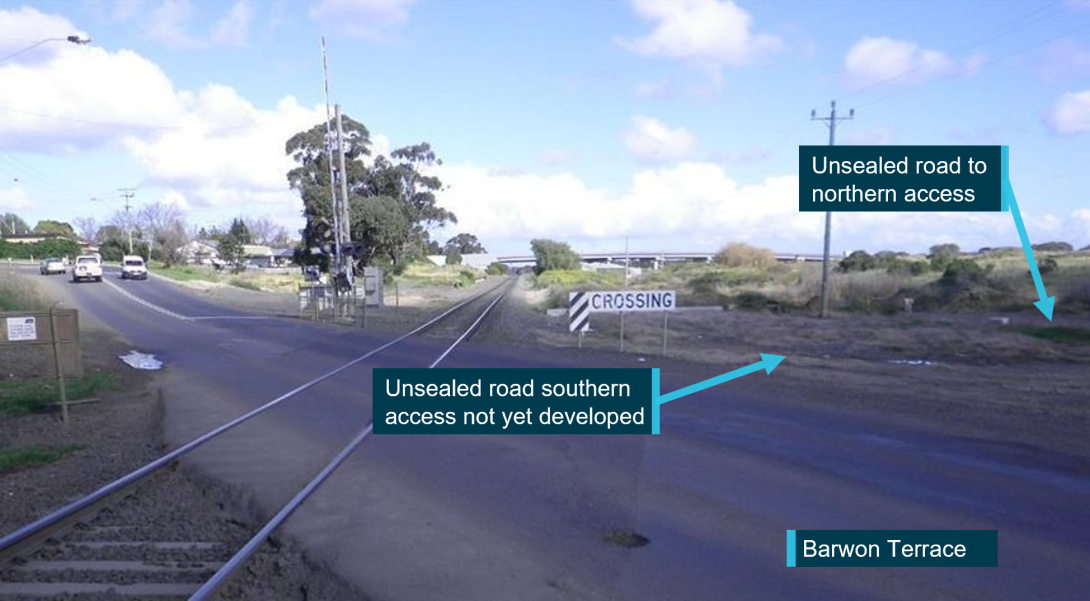
In 2017, the unsealed road joined Barwon Terrace north of the level crossing. The access pathway used by the truck on the day of the incident had not yet developed. Source: ALCAM 2017 survey assessment
Activity in area
Heavy vehicle depot
The truck involved in the incident operated out of a heavy vehicle depot situated on a parcel of land located along the unsealed road south of Barwon Terrace. The land was owned by a management consulting firm and was leased to an earth moving company which based its operations at the depot. The parcel of land did not border Barwon Terrace directly. The northern end of the property was about 210 m south of the Barwon Terrace level crossing.
Several trucks operated out of the depot and undertook works for the earth moving company and regularly exited the depot using the unsealed road to access Barwon Terrace. On the day of the incident the truck drove north from the heavy vehicle depot along the unsealed road before driving onto the Barwon Terrace level crossing.
At the time of the incident, the firm that owned the parcel of land on which the heavy vehicle depot was located had not submitted the requisite planning permit to operate a contractor’s depot at the site. Between December 2020 and July 2021, the City of Great Geelong (COGG) wrote a series of letters to the firm regarding this alleged breach of the COGG Planning Scheme. The letters advised that a retrospective planning permit application was required and provided the landowner an opportunity to show why COGG should not take enforcement action for the unauthorised use and development of the land. At the time of the collision, a permit had not been issued and the matter was unresolved.
Rail corridor project
Djilang Alliance (the Alliance) was contracted to deliver a rail line duplication project between South Geelong and Waurn Ponds and was working in the area. The Alliance consortium comprised McConnell Dowell, Downer, Arup and WSP.
In the months prior to the collision, the Alliance was conducting works around Barwon Terrace level crossing. The Alliance advised that in the February prior to the collision, they began placing a temporary barrier around the Alliance worksite at the northern end of the unsealed road. The barrier was to extend out from the Alliance worksite and around to the north of the power pole and would block the unsealed road southern access route near the track. However, the owner of the land being used by the heavy vehicle depot asked that the barriers be removed to allow vehicles to access the unsealed road by turning left from Barwon Terrace when approaching from the south. The Alliance advised that their protocols[11] required that landowners not be disturbed, and the barrier was removed and repositioned more tightly around the Alliance worksite.
By the time of the collision, Alliance works near the level crossing had been completed and the works location had moved further south. Alliance activities were then at the southern end of the unsealed road, about 560 m from the level crossing. Access from the Alliance worksite onto Barwon Terrace was via the unsealed road.
The unsealed road
Overview
The road was located on Victorian government‑owned (crown) land but was not recognised as a road by COGG or the Victorian government and had not been named. The road ran in a southerly direction for about 560 m from Barwon Terrace where, at its southern end, it terminated close to the Alliance worksite and Breakwater Road in South Geelong. It did not join Breakwater Road. At its northern end, the unsealed road terminated on the western side of Barwon Terrace. The junction between the unsealed road and Barwon Terrace extended from north of the level crossing, southward to the middle of the crossing, a distance of about 40 m.
Usage
Earlier usage
The history of the unsealed road and its usage was examined. It is probable that the junction between the unsealed road, Barwon Terrace and the Barwon Terrace level crossing was not inhibited by any fencing in the years prior to the incident.[12] This absence of a physical barrier meant that road vehicles could turn left or right onto Barwon Terrace from any point along the junction with the unsealed road and adjacent land. Vehicles could also enter the area by turning left or right from Barwon Terrace.
Imagery and associated evidence indicate that the historic primary access to and from the unsealed road was around 30–40 m north of the rail track crossing and north of a nearby power pole. Over time, access had developed closer to the rail corridor and track (Figure 6).
Figure 6: Train route and location of Barwon Terrace level crossing
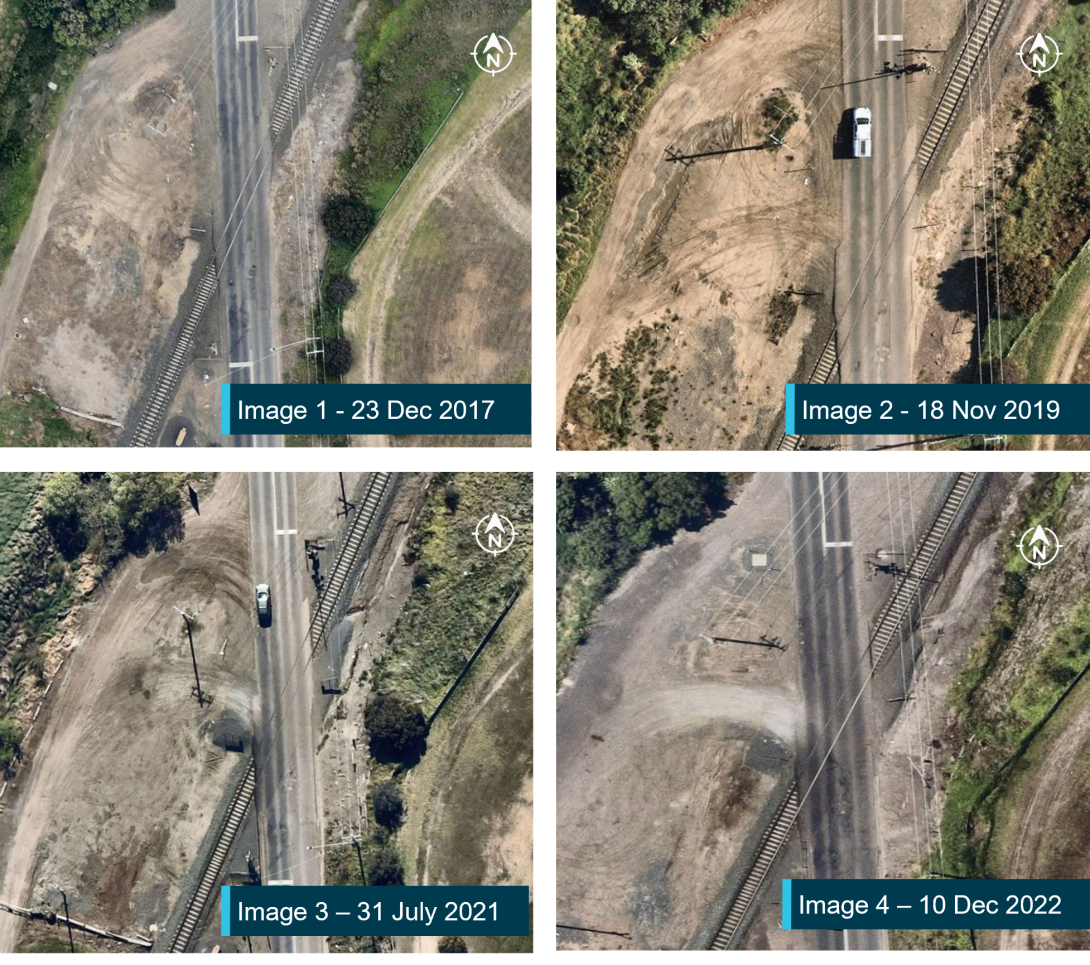
Source: Nearmap, annotated by the Office of the Chief Investigator
An overhead photograph of the intersection taken 4 months before the collision (Figure 6, Image 4) showed that use of the access near the track and south of the power pole had increased. This access was probably used by vehicles turning right from the unsealed road onto Barwon Terrace and vehicles turning left off Barwon Terrace onto the unsealed road.
Recent usage
CCTV footage, sourced from the heavy vehicle depot, showed that in the weeks prior to the incident, light and heavy motor vehicles were often driven onto the Barwon Terrace level crossing from the unsealed road. This positioned the vehicles between the protection equipment on each side of the crossing. These vehicles included flatbed light trucks, utility vehicles, four-wheel drive vehicles and tip trucks.
Footage of the previous weeks also showed that, on occasion, vehicles were driven onto the crossing moments after a V/Line train had gone through the crossing but before the boom gates had risen.
Hazard identification
On 9 March 2023, prior to the collision and after an Alliance safety officer observed an Alliance vehicle turning right onto Barwon Terrace into the middle of the level crossing, a no right turn sign[13] was affixed to the power pole (Figure 7). The sign faced south towards traffic approaching from along the unsealed road. During ‘Pre-start’ and ‘Safe Talks’ at team meetings, Alliance personnel were also advised that they were not to turn right when exiting the unsealed road onto Barwon Terrace. V/Line personnel were present at some safety meetings.
Figure 7: No right turn sign on the power pole
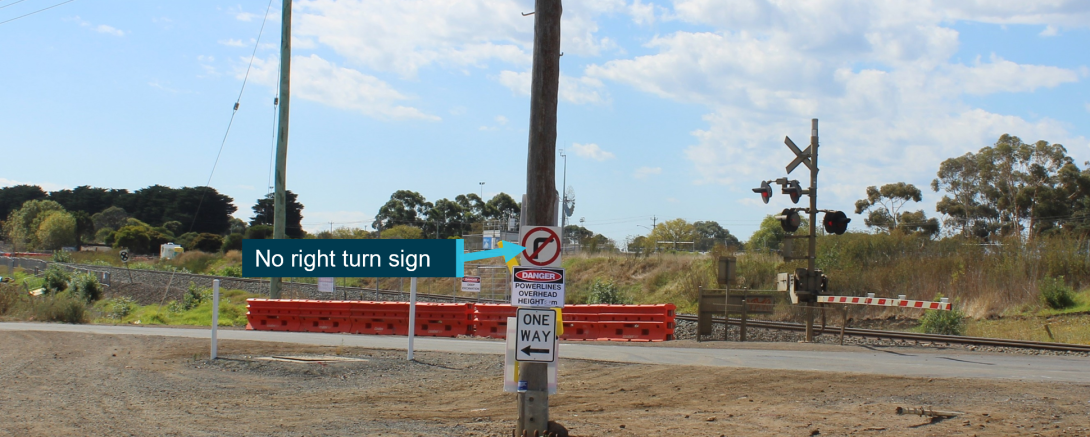
Photograph showing the no right turn sign on the power pole. Source: The Office of the Chief Investigator
The truck driver and truck
The truck driver had worked for the earth moving company for approximately 1 month prior to the incident.[14] They were licensed to drive the truck and had had many years of experience as a truck driver. The truck driver was fatally injured in the collision.
The truck was a 1997 International tip truck and was owned by the earth moving company (Figure 8). The truck’s dump body was empty at the time of the collision.
Figure 8: A similar tip truck to that involved in the collision
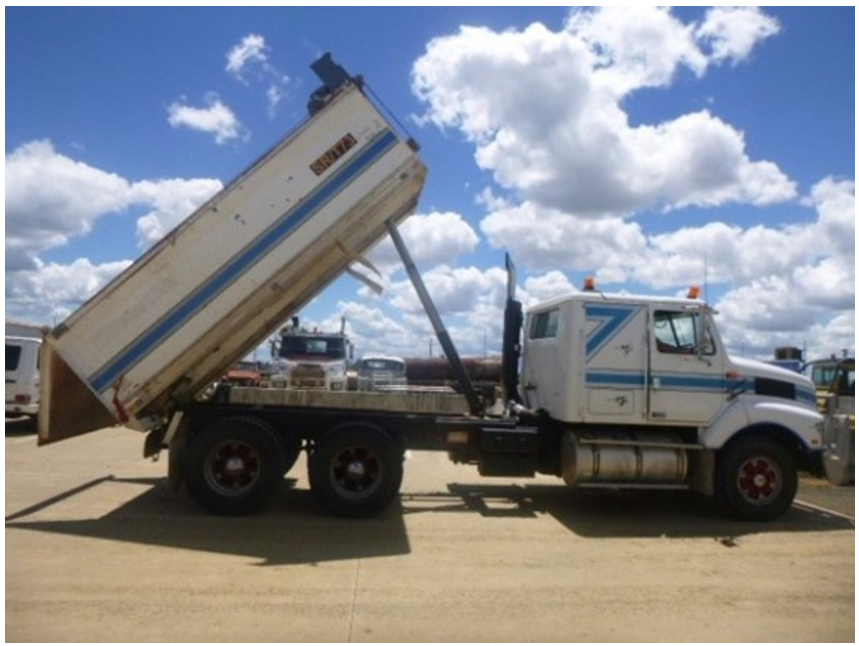
The truck involved in the incident was of a type like that at Figure 8, but red in colour. Source: Google
The train driver and train
The train driver was qualified, assessed as competent and medically fit at the time of the collision. The train sustained minor damage to its front, did not derail and was able to be driven to the Waurn Ponds stabling yard.
Passenger train 7727 was a VLocity six car set which was being relocated to Waurn Ponds railway station for a passenger service to Melbourne later that morning. The only persons on board the train at the time of the incident were the train driver and conductor. Both were unhurt.
Figure 9: Damage to the front of train 7727
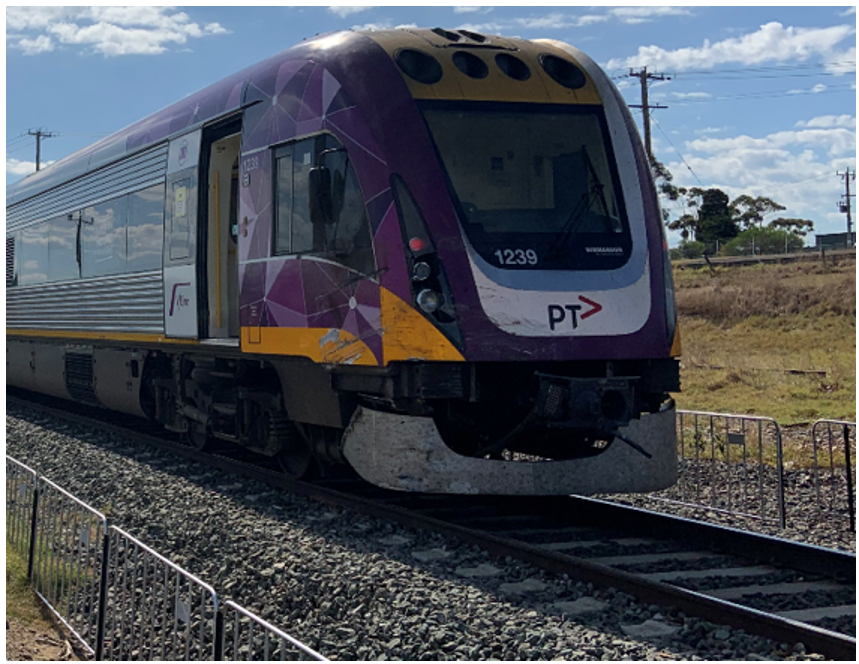
The damage to the front of VLocity train 7727 following the incident. Source: The Office of the Chief Investigator
Recorded information
Recorded information was sourced from a CCTV camera positioned at the heavy vehicle depot, the train’s data logger and from the level crossing data logger. Time references were corrected, and events aligned. The key events are shown in Table 1.
Table 1: Key events in lead‑up to collision
| Time (h:m:s) | Event | Approx. train distance from level crossing (m) |
| 6:35:44 | Truck departs depot | 1350 |
| 6:36:18 | Bells and lights commence | 660 |
| 6:36:29 | Boom barriers commence to descend | 450 |
| 6:36:32 | Train passes whistle board (no horn recorded) | 400 |
| 6:36:37 | Truck commences right turn towards level crossing | 290 |
| 6:36:38 | Boom barriers reach their horizontal position | 270 |
| 6:36:45 | Train brake application commences | 120 |
| 6:36:46 | First of several train horn applications | 107 |
| 6:36:50 | Truck is stopped on level crossing | 30 |
| 6:36:51 | Truck begins to reverse away from track | 15 |
| 6:36:52 | Level crossing island track detection of train and collision | 0 |
Safety analysis
Introduction
On 3 April 2023, at about 0631, empty V/Line passenger train 7727 left Geelong to travel to Waurn Ponds. At about 0636, as the train approached the Barwon Terrace level crossing in South Geelong, a tip truck drove onto the level crossing from an unsealed side road. Moments later, the train collided with the truck and the truck driver sustained fatal injuries. The driver of the train and the conductor were uninjured.
This analysis discusses:
- the context and circumstances of the collision
- the configuration at the intersection
- risk controls at the unsealed road exit onto Barwon Terrace
- risk management at the level crossing.
The context and circumstances of the collision
Use of the unsealed road
Imagery indicated that usage of the unsealed side road had increased over recent years. This increase was probably coincidental with increased usage by vehicles from the heavy vehicle depot located about 220 m south of the level crossing. The owner of the land at the depot had not submitted a planning permit application for the land use and correspondence from 2020 and 2021 between the City of Greater Geelong and the landowner had not resolved the permit issue.
In the weeks leading up to the level crossing collision, CCTV footage showed several trucks, light commercial vehicles and cars turning right from the unsealed road onto Barwon Terrace. Based on this evidence, it was probably common practice for vehicles to use this route when leaving the unsealed road.
|
Other factor that increased risk It was probably common practice for both light and heavy vehicles to turn right from the unsealed road onto Barwon Terrace and between the level crossing protection of booms and flashing lights located on each side of the crossing. |
Movement of the tip truck
The truck turned right from the unsealed road onto Barwon Terrace behind the protection equipment located on the north side of the crossing. This route was probably not unusual for vehicles wanting to travel south along Barwon Terrace. For the turn onto Barwon Terrace, it is probable that the driver’s attention was directed to road traffic from both directions to assure safe entry onto the road.
The level crossing flashing lights and bells were operating before the truck commenced its turn into Barwon Terrace, and the booms were descending to their down position as the truck started its turn. All protection equipment was working correctly at the time of the incident but may not have been observed by the driver.
As the truck turned onto Barwon Terrace to travel south, cars began to queue behind the boom barrier on the south side of the crossing. The train’s horn was also sounded when the train was about 107 m from the crossing. By either observation of the queued traffic and the descended boom to the south of the crossing, hearing the train’s horn, or observation of the train, the driver was probably alerted to the presence of an approaching train. The truck was stopped on the track and its driver attempted to clear the track by reversing their vehicle. However, they were not able to clear the track before the train collided with the forward part of the truck.
|
Contributing factor The truck entered the level crossing between the level crossing protection equipment on either side of the track and stopped on the track. The driver probably realised a train was approaching and reversed the truck but was unable to clear the track in time. |
The sounding of the train’s horn
Train data logger records did not indicate that the train’s horn had been sounded at the whistle board which was located about 400 m before the crossing. The horn was either not sounded or was sounded for a very short period that was not recorded by the logger.
It is unknown whether the driver of the truck would have heard the train’s horn over the truck cab’s ambient noise if the horn was sounded at 400 m distance and if heard, whether the driver would have recognised the sound as a warning of an approaching train.
|
Other factor that increased risk The train’s horn was not sounded or only sounded for a very short period at the whistle board located about 400 m from the level crossing, removing a potential audible warning to users of the level crossing. |
The configuration of the intersection
The acute angle between Barwon Terrace and the track meant that there was about 22 m between the rail track and the stop line where the unsealed road connected with Barwon Terrace. This large distance provided an opportunity for road vehicles to turn right from the unsealed road onto the level crossing behind the northern protection equipment. There was no barrier in place to prevent this high‑risk entry of vehicles onto the level crossing.
|
Contributing factor The configuration of the intersection between the unsealed road and Barwon Terrace allowed road vehicles to enter Barwon Terrace between the protection equipment on the northern side of the level crossing and the track. This rendered the protection on the northern side of the crossing ineffective for these vehicles. |
Risk controls at the unsealed road exit onto Barwon Terrace
At the time of the collision, road traffic control measures at the northern end of the unsealed road where it joined Barwon Terrace included signage. The Alliance advised that a ‘no right turn’ sign had been put in place a few weeks before the collision after the Alliance identified a risk associated with Alliance vehicles turning right onto the level crossing. However, CCTV footage indicated that some vehicles continued to turn right onto Barwon Terrace after the sign was placed. The sign was ineffective in deterring some drivers from continuing to turn right from the unsealed road onto Barwon Terrace.
In addition to normal road‑facing flashing lights to warn of approaching trains, the level crossing protection on the northern side of the crossing also included a single flashing light angled towards the unsealed road. However, this warning signal was directed towards the northern exit of the intersection rather than the exit closer to the rail track. Drivers of vehicles taking this right turn, including the truck involved in the collision, would typically not see this light.
|
Other factor that increased risk Risk controls put in place to prevent vehicles turning right from the unsealed road onto Barwon Terrace and between the crossing’s protection equipment were ineffective. |
Risk management at the level crossing
Rail infrastructure manager
This section of the rail network including the level crossing infrastructure was managed by V/Line. V/Line routine inspection of the level crossing reviewed the functionality of crossing equipment and the condition of signage. However, the inspection regime did not extend to identifying road geometry conditions that may heighten risk. An individualised risk assessment specific to the level crossing had not been conducted and there was no clear process to identify the changing conditions at the level crossing.
Safety interface agreement
The Safety Interface Agreement (SIA) between road and rail managers that covered the Barwon Terrace level crossing did not identify any specific rail or road safety hazards associated with the interface between the unsealed road and Barwon Terrace. Flagging of the specific risks in the SIA may have provided an opportunity for all parties (including the road manager) to take proactive action in monitoring and addressing risks at the crossing.
|
Other factor that increased risk The Safety Interface Agreement between rail and road managers did not identify potential risks associated with the Barwon Terrace level crossing nor flag any requirement for special attention of the road configuration. |
Australian level crossing assessment model (ALCAM)
The Australian Level Crossing Assessment Model (ALCAM) assessment in 2017 and review in 2018 did not identify any specific risks to road or rail traffic at the junction between the unsealed road and Barwon Terrace other than the possibility that road vehicles may be driven around the boom gates. At the time of the 2017 survey, access to and from the unsealed road was probably at its intersection with Barwon Terrace about 30–40 m north of the track and not via the access route closer to the track, the use of which probably increased substantially after the survey.
ALCAM assessment is a risk-based process against requirements of the relevant Australian Standard, and it was unclear if processes included directly flagging unusual side road access. There may be an opportunity for ALCAM survey processes to include direct flagging of unusual and potentially changed road configurations.
|
Other finding The unsealed road access route close to the level crossing probably developed after the 2017 survey of the Barwon Terrace level crossing using the Australian Level Crossing Assessment Model (ALCAM), and the ALCAM survey report did not identify the route. |
Hazard identification and communication
In the months preceding the incident, the risk of a collision between road and rail traffic at the level crossing was identified by safety personnel associated with rail works in the corridor. In response, a no right turn sign was erected on the power pole at the north end near the exit from the unsealed road onto Barwon Terrace.
In the weeks prior to the incident, the hazard associated with vehicles accessing Barwon Terrace by turning right from the unsealed road was again identified by onsite rail project safety personnel and raised at safety and pre-start meetings. Some of these meetings included V/Line representatives.
In addition to briefing rail project workers about the hazard, additional signage prohibiting a right turn from the unsealed road onto Barwon Terrace was erected as a risk control. However, there was a missed opportunity for the safety concerns to be raised with the appropriate operational area of V/Line, either by the rail project directly or V/Line representatives onsite.
|
There was a missed opportunity for identified hazards associated with the level crossing configuration to be brought to the attention of the appropriate operational area within V/Line. |
Findings
|
ATSB investigation report findings focus on safety factors (that is, events and conditions that increase risk). Safety factors include ‘contributing factors’ and ‘other factors that increased risk’ (that is, factors that did not meet the definition of a contributing factor for this occurrence but were still considered important to include in the report for the purpose of increasing awareness and enhancing safety). In addition, ‘other findings’ may be included to provide important information about topics other than safety factors. Safety issues are highlighted in bold to emphasise their importance. A safety issue is a safety factor that (a) can reasonably be regarded as having the potential to adversely affect the safety of future operations, and (b) is a characteristic of an organisation or a system, rather than a characteristic of a specific individual, or characteristic of an operating environment at a specific point in time. These findings should not be read as apportioning blame or liability to any particular organisation or individual. |
From the evidence available, the following findings are made with respect to the collision between a truck and V/Line train 7727 at Barwon Terrace level crossing, South Geelong, Victoria on 3 April 2023.
Contributing factors
- The configuration of the intersection between the unsealed road and Barwon Terrace allowed road vehicles to enter Barwon Terrace between the protection equipment on the northern side of the level crossing and the track. This rendered the protection on the northern side of the crossing ineffective for these vehicles.
- The truck entered the level crossing between the level crossing protection equipment on either side of the track and stopped on the track. The driver probably realised a train was approaching and reversed the truck but was unable to clear the track in time.
Other factors that increased risk
- The train’s horn was not sounded or only sounded for a very short period at the whistle board located about 400 m from the level crossing, removing a potential audible warning to users of the level crossing.
- It was probably common practice for both light and heavy vehicles to turn right from the unsealed road onto Barwon Terrace and between the level crossing protection of booms and flashing lights located on each side of the crossing.
- Risk controls put in place to prevent vehicles turning right from the unsealed road onto Barwon Terrace and between the crossing’s protection equipment were ineffective.
- V/Line inspection regime did not identify that the interface between the unsealed road and Barwon Terrace level crossing was a safety risk. Inspections did not extend to the routine review of any changes to the configuration at the interface that may heighten risk. (Safety issue)
- The Safety Interface Agreement between rail and road managers did not identify potential risks associated with the Barwon Terrace level crossing nor flag any requirement for special attention of the road configuration.
Other findings
- The unsealed road access route close to the level crossing probably developed after the 2017 survey of the Barwon Terrace level crossing using the Australian Level Crossing Assessment Model (ALCAM), and the ALCAM survey report did not identify the route.
- There was a missed opportunity for identified hazards associated with the level crossing configuration to be brought to the attention of the appropriate operational area within V/Line.
Safety issues and actions
|
Central to the ATSB’s investigation of transport safety matters is the early identification of safety issues. The ATSB expects relevant organisations will address all safety issues an investigation identifies. Depending on the level of risk of a safety issue, the extent of corrective action taken by the relevant organisation(s), or the desirability of directing a broad safety message to the Rail industry, the ATSB may issue a formal safety recommendation or safety advisory notice as part of the final report. Descriptions of each safety issue, and any associated safety recommendations, are detailed below. Click the link to read the full safety issue description, including the issue status and any safety action/s taken. Safety issues and actions are updated on this website when safety issue owners provide further information concerning the implementation of safety action. |
Monitoring level crossing risks associated with road configuration
Safety issue number: RO-2023-003-SI-001
Safety issue description: V/Line inspection regime did not identify that the interface between the unsealed road and Barwon Terrace level crossing was a safety risk. Inspections did not extend to the routine review of any changing road conditions that may heighten risk.
Safety actions not associated with an identified safety issue
| Whether or not the ATSB identifies safety issues in the course of an investigation, relevant organisations may proactively initiate safety action in order to reduce their safety risk. The ATSB has been advised of the following additional proactive safety action in response to this occurrence. |
Additional safety action by The Djilang Alliance
The Djilang Alliance advised that on completion of the rail upgrade works, the interface between the Barwon Terrace level crossing and the unsealed road was upgraded. A fence and bollards were installed which prevented motor vehicles turning right from the unsealed road onto the middle of the level crossing.
Additional safety action by the Victorian Rail Crossing Safety Steering Committee
The Victorian Rail Crossing Safety Steering Committee (VRCSSC) has implemented changes to the Australian Level Crossing Assessment Model (ALCAM) survey program in Victoria, which now requires contractors undertaking assessments to identify and report any road network configurations like the incident location. Once reported, the rail infrastructure manager would be notified of the safety risk and further assessment and actions sought. Further, the ALCAM survey program has been accelerated over the previous 3 years, and by December 2025 all public level crossings in Victoria are scheduled to have had an assessment completed within the previous 5 years.
Glossary
| ALCAM | Australian Level Crossing Assessment Model |
| Alliance | The Djilang Alliance |
| COGG | City of Greater Geelong |
| V/Line | V/Line Corporation |
| VRCSSC | Victorian Rail Crossing Safety Steering Committee |
Sources and submissions
Sources of information
The sources of information during the investigation included:
- accident witnesses
- Australian Level Crossing Assessment Model
- City of Greater Geelong
- data download information from Barwon Terrace level crossing
- data download information from train 7727 data recorder
- Department of Transport and Planning (Victoria)
- Djilang Alliance
- Lukarna Constructions Pty Ltd
- Victoria Police
- video footage and photographs taken on days and weeks prior to the accident
- video footage of the accident and other photographs and videos taken on the day of the accident
- V/Line Corporation.
Submissions
Under section 26 of the Transport Safety Investigation Act 2003, the ATSB may provide a draft report, on a confidential basis, to any person whom the ATSB considers appropriate. That section allows a person receiving a draft report to make submissions to the ATSB about the draft report.
A draft of this report was provided to directly involved parties. Submissions were reviewed and, where considered appropriate, the text of the report was amended accordingly.
Purpose of safety investigationsThe objective of a safety investigation is to enhance transport safety. This is done through:
It is not a function of the ATSB to apportion blame or provide a means for determining liability. At the same time, an investigation report must include factual material of sufficient weight to support the analysis and findings. At all times the ATSB endeavours to balance the use of material that could imply adverse comment with the need to properly explain what happened, and why, in a fair and unbiased manner. The ATSB does not investigate for the purpose of taking administrative, regulatory or criminal action. TerminologyAn explanation of terminology used in ATSB investigation reports is available here. This includes terms such as occurrence, contributing factor, other factor that increased risk, and safety issue. Publishing informationReleased in accordance with section 25 of the Transport Safety Investigation Act 2003 Published by: Australian Transport Safety Bureau © Commonwealth of Australia 2025
Ownership of intellectual property rights in this publication Unless otherwise noted, copyright (and any other intellectual property rights, if any) in this report publication is owned by the Commonwealth of Australia. Creative Commons licence With the exception of the Commonwealth Coat of Arms, ATSB logo, and photos and graphics in which a third party holds copyright, this report is licensed under a Creative Commons Attribution 4.0 International licence. The CC BY 4.0 licence enables you to distribute, remix, adapt, and build upon our material in any medium or format, so long as attribution is given to the Australian Transport Safety Bureau. Copyright in material obtained from other agencies, private individuals or organisations, belongs to those agencies, individuals or organisations. Where you wish to use their material, you will need to contact them directly. |
[1] The 'unsealed road' was not recognised as a public road.
[2] The train’s emergency brake was applied immediately following the application of the train’s service brake.
[3] VicTrack was a Victorian government‑owned organisation which owned Victoria’s rail land, buildings, infrastructure and rolling stock and leased those assets to the Department of Transport and Planning (a Victorian government department). Those assets were then sub-leased to rail companies.
[4] A statutory office established under the Transport Integration Act 2010.
[5] The relevant Safety Interface Agreement and Service Level Agreement stated that V/Line was responsible for the management and maintenance of the level crossing within 3 m of the outer running rail only.
[6] The RX-5 assembly consisted of an R6-25 Railway Crossing sign and an R6-9 Stop on Red Signal sign.
[7] The RX-9 assembly consisted of an RX-9(L) sign and an RX-9(R) sign.
[8] V/Line did not undertake any assessment or testing of infrastructure outside of the area of its control.
[9] ALCAM is owned by the National ALCAM Committee. The Rail Industry Safety Standards Board helps to support the system.
[10] ALCAM in Detail – An Introduction to the new ALCAM models (2014), page 15.
[11] The Alliance advised that this protocol was an informal, unwritten protocol.
[12] Overhead images (Source: Nearmap) of the level crossing and its junction with the unsealed road spanning 10 years prior to the incident do not indicate the presence of a fence at the intersection.
[13] ‘No right turn’ sign - (R2-6(R), AS 1742.2:2022 – Manual of uniform traffic control devices, Part 2: Traffic control devices for general use.
[14] The earth moving company operated out of the depot on the unsealed road.



